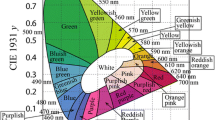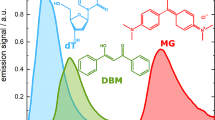Abstract
Organic dyes have great potential for its use in solar cells. In this recent work, the molecular structure and properties of Dye 7 were obtained using density functional theory (DFT) and different levels of calculation. Upon comparing the molecular structure and the ultraviolet visible spectrum with experimental data reported in the literature, it was found that the M05-2X/6-31G(d) level of calculation gave the best approximation. Once the appropriate methodology had been obtained, the molecule was characterized by obtaining the infrared spectrum, dipole moment, total energy, isotropic polarizability, molecular orbital energies, free energy of solvation in different solvents, and the chemical reactivity sites using the condensed Fukui functions.





Similar content being viewed by others
Abbreviations
- DFT:
-
Density functional theory
- TD-DFT:
-
Time-dependent density functional theory
- IR:
-
Infrared
- UV-vis:
-
Ultraviolet
- Å:
-
Angstrom
- λ max :
-
Wavelength of maximum absorption
- THF:
-
Tetrahydrofuran
- HOMO:
-
Highest occupied molecular orbital
- LUMO:
-
Lowest unoccupied molecular orbital
- ΔG(solv):
-
Free energy of solvation
- IEF-PCM:
-
Integral equation formalism of the polarized continuum model
References
Grätzel M (2006) Photovoltaic performance and long-term stability of dye-sensitized meosocopic solar cells. C R Chimie 9:578–583. doi:10.1016/j.crci.2005.06.037
Grätzel M (2003) Dye-sensitized solar cells. J Photochem Photobiol C 4:145–153. doi:10.1016/S1389-5567(03)00026-1
Grätzel M (2004) Conversion of sunlight to electric power by nanocrystalline dye-sensitized solar cells. J Photochem Photobiol A 164:3–14. doi:10.1016/j.jphotochem.2004.02.023
Fan Z, Yan H, Jin S, Xiao Z, Wei L, Chun M, Yong H, Mao F, Zhishan B, Qing M (2009) Triphenylamine-based dyes for dye-sensitized solar cells. Dyes Pigments 81:224–230. doi:10.1016/j.dyepig.2008.10.012
Hwang S, Lee J, Park C, Lee H, Kim C, Park C, Lee M, Lee W, Park J, Kim K, Park N, Kim C (2007) A highly efficient organic sensitizer for dye-sensitized solar cells. Chem Commun 2007:4887–4889. doi:10.1039/b709859f
Buscaino R, Baiocchi C, Barolo C, Medana C, Grätzel M, Nazeeruddin M, Viscardi G (2008) A mass spectrometric analysis of sensitizer solution used for dye-sensitized solar cell. Inorg Chim Acta 361:798–805. doi:10.1016/j.ica.2007.07.016
Tachan Z, Rühle S, Zaban A (2010) Dye-sensitized solar tubes: a new solar cell design for efficient current collection and improved cell sealing. Sol Energ Mater Sol Cells 94:317–322
Shen P, Liu Y, Huang X, Zhao B, Xiang N, Fei J, Liu L, Wang X, Huang H, Tan S (2009) Efficient triphenylamine dyes for solar cells: effects of alkyl-substituents and π-conjugated thiophene unit. Dyes Pigments 83:187–197. doi:10.1016/j.dyepig.2009.04.005
Chang Y, Chow T (2009) Dye-sensitized solar cell utilizing organic dyads containing triarylene conjugates. Tetrahedron 65:4726–4734
Casanova D, Rotzinger F, Grätzel M (2010) Computational study of promising organic dyes for high-performance sensitized solar cells. J Chem Theor Comput 6:1219–1227. doi:10.1021/ct100069q
El-Shishtawy R (2009) Functional dyes, and some hi-tech applications. Int J Photoenergy 2009:1–21. doi:10.1155/2009/434897
Hagberg D, Edvinsson T, Sun L (2006) A novel organic chromophore for dye-sensitized nanostructured solar cells. Chem Commun 2245–2247. doi:10.1039/b603002e
Parr R, Yang W (1989) Density-functional theory of atoms and molecules. Oxford University Press, Oxford
Frisch MJ et al (2004) Gaussian 03W. Gaussian Inc., Wallingford
Foresman J, Frisch A (1996) Exploring chemistry with electronic structure methods. Gaussian Inc., Pittsburgh
Becke A (1993) Density-functional thermochemistry. III. The role of exact exchange. J Chem Phys 98:5648–5652. doi:10.1063/1.464913
Becke A (1988) Density functional exchange energy approximation with correct asymptotic behavior. Phys Rev A 38:3098–3100. doi:10.1103/PhysRevA.38.3098
Lee C, Yang W, Parr R (1988) Development of the Colle–Salvatti correlation-energy formula into a funtional of the electron density. Phys Rev B 37:785–789. doi:10.1103/PhysRevB.37.785
Stephens P, Devlin F, Chabalowski C, Frisch M (1994) Ab initio calculation of vibrational absorption and circular dichroism spectra using density functional Force fields. J Phys Chem 98:11623–11627. doi:10.1021/j100096a001
Ernzerhof M, Scuseria G (1999) Assessment of the Perdew–Burke–Ernzerhof exchange-correlation functional. J Chem Phys 110:5029–5036. doi:10.1063/1.478401
Adamo C, Barone V (1999) Toward reliable density functional methods without adjustable parameters: the PBE0 model. J Chem Phys 110:6158–6170. doi:10.1063/1.478522
Tao J, Perdew J, Staroverov V, Scuseria G (2003) Climbing the density functional ladder: non-empirical meta-generalized gradient approximation designed for molecules and solids. Phys Rev Lett 91:1–4. doi:10.1103/PhysRevLett.91.146401
Staroverov V, Scuseria G, Tao J, Perdew J (2003) Comparative assessment of a new nonempirical density functional: molecules and hydrogen-bonded complexes. J Chem Phys 119:12129–12137. doi:10.1063/1.1626543
Zhao Y, Schultz N, Truhlar D (2006) Design of density functionals by combining the method of constraint satisfaction with parametrization for thermochemistry, thermochemical kinetics, and noncovalent interactions. J Chem Theor Comput 2:364–382. doi:10.1021/ct0502763
Lewars E (2003) Computational chemistry: introduction to the theory and applications of molecular and quantum mechanics. Kluwer, Norwell
Young D (2001) Computational chemistry: a practical guide for applying techniques to real-world problems. Wiley, New York
Jensen F (2007) Introduction to computational chemistry. Wiley, Chichester
Cramer C (2002) Essentials of computational chemistry: theories and models. Wiley, Chichester
Burke K, Werschnik J, Gross E (2005) Time-dependent density functional theory: past, present, and future. J Chem Phys 123:1–9. doi:10.1063/1.1904586
Stratmann R, Scuseria G, Frisch M (1998) An efficient implementation of time-dependent density-functional theory for the calculation of excitation energies of large molecules. J Chem Phys 109:8218–8224. doi:10.1063/1.477483
Bauernschmitt R, Ahlrichs R (1996) Treatment of electronic excitations within the adiabatic approximation of time dependent density functional theory. Chem Phys Lett 256:454–464. doi:10.1016/0009-2614(96)00440-X
Casida M, Jamorski C, Casida K, Salahub D (1998) Molecular excitation energies to high-lying bound states from time-dependent density-functional response theory: characterization and correction of the time-dependent local density approximation ionization threshold. J Chem Phys 108:4439–4449. doi:10.1063/1.475855
Gorelsky S (2010) SWizard program. http://www.sg-chem.net/, accessed 29 Sept 2010
Gorelsky S (2010) AOMix program. http://www.sg-chem.net/, accessed 10 Sept 2010
Gorelsky S, Lever A (2001) Electronic structure and spectra of ruthenium diimine complexes by density functional theory and INDO/S. Comparison of the two methods. J Organomet Chem 635:187–196. doi:10.1016/S0022-328X(01)01079-8
Green M (1982) Solar cells: operating principles, technology, and systems applications. Prentice-Hall, Upper Saddle River
De Angelis F, Fantacci S, Sgamelloti A (2007) An integrated computational tool for the study of the optical properties of nanoscale devices: application to solar cells and molecular wires. Theor Chem Acc 117:1093–1104. doi:10.1007/s00214-006-0224-z
Weng Y, Wang Y, Asbury J, Ghosh H, Lian T (2000) Back electron transfer from TiO2 nanoparticles to FeIII(CN)6 3−: origin of non-single-exponential and particle size independent dynamics. J Phys Chem B 104:93–104. doi:10.1221/jp992522a
Sharma S, Inamdar A, Im H, Kim B, Patil P (2011) Morphology dependent dye-sensitized solar cell properties of nanocrystallyne zinc oxide thin films. J Alloys Compd 509:2127–2131. doi:10.1016/j.jallcom.2010.10.163
Acknowledgments
This work was made possible by the support of Universidad Autónoma de Sinaloa through the Facultad de Ingeniería Mochis, by the PROFAPI2010/033 project, Centro de Investigación en Materiales Avanzados, S.C. (CIMAV), and Consejo Nacional de Ciencia y Tecnología.
Author information
Authors and Affiliations
Corresponding author
Rights and permissions
About this article
Cite this article
Baldenebro-López, J., Castorena-González, J., Flores-Holguin, N. et al. Computational characterization of the molecular structure and properties of Dye 7 for organic photovoltaics. J Mol Model 18, 835–842 (2012). https://doi.org/10.1007/s00894-011-1120-6
Received:
Accepted:
Published:
Issue Date:
DOI: https://doi.org/10.1007/s00894-011-1120-6




